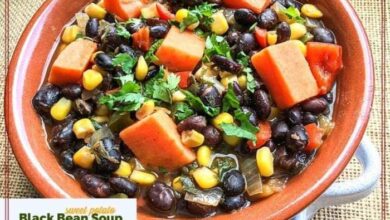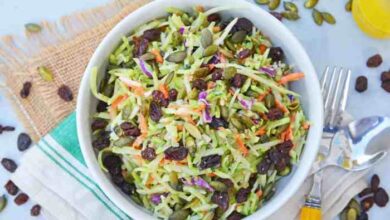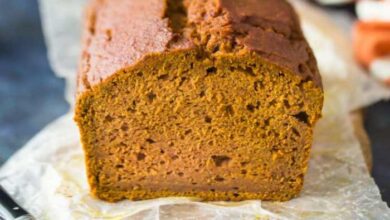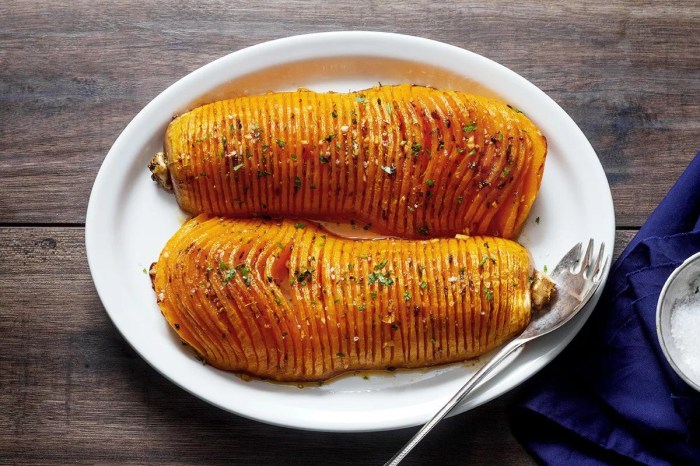
Simple Roasted Butternut Squash: A Versatile Side Dish
Simple roasted butternut squash takes center stage, a humble yet versatile ingredient that can elevate any meal. From its vibrant orange hue to its subtly sweet flavor, butternut squash is a kitchen staple for good reason. Its nutty sweetness pairs beautifully with savory dishes, and its rich texture makes it a delightful side dish or ingredient in countless recipes.
Butternut squash is also a nutritional powerhouse, packed with vitamins, minerals, and antioxidants, making it a delicious and healthy addition to your diet.
This guide will walk you through the simple steps of roasting butternut squash, from preparation to flavor variations, ensuring you achieve perfectly roasted, flavorful squash every time. Whether you’re a seasoned cook or a culinary novice, this guide will equip you with the knowledge and tips to make the most of this versatile ingredient.
Butternut Squash: A Simple Yet Versatile Side Dish
Butternut squash is a winter squash with a sweet, nutty flavor and a vibrant orange flesh. Its versatility in cooking makes it a popular choice for both savory and sweet dishes. From soups and stews to roasted sides and even desserts, butternut squash can be enjoyed in countless ways.
While it can be incorporated into complex recipes, the simplicity of roasting butternut squash brings out its natural sweetness and adds a delightful touch to any meal.This simple roasting method allows the squash’s natural flavors to shine through, making it a perfect side dish for various meals.
It pairs well with both meat and vegetarian dishes, adding a touch of sweetness and color to your plate. Moreover, the roasting process intensifies its natural sweetness and creates a tender, melt-in-your-mouth texture.
Nutritional Benefits of Butternut Squash
Butternut squash is a nutritional powerhouse, packed with essential vitamins, minerals, and antioxidants. Here are some of its key health benefits:
- Rich in Vitamin A:Butternut squash is an excellent source of Vitamin A, crucial for healthy vision, skin, and immune function. A single cup of cooked butternut squash provides more than 200% of the daily recommended intake of Vitamin A.
- Good Source of Fiber:The high fiber content in butternut squash aids in digestion, promotes regularity, and helps control blood sugar levels. It also contributes to a feeling of fullness, making it a great addition to a weight management plan.
- Antioxidant Powerhouse:Butternut squash is rich in antioxidants, such as beta-carotene and vitamin C, which protect cells from damage caused by free radicals. These antioxidants contribute to overall health and may reduce the risk of chronic diseases.
- Provides Essential Minerals:Butternut squash is a good source of potassium, which helps regulate blood pressure and muscle function. It also contains magnesium, which supports bone health and energy production.
Preparation
Preparing butternut squash for roasting is straightforward and involves a few simple steps. This process ensures that the squash cooks evenly and yields a tender, flavorful result.
Simple roasted butternut squash is a staple in my kitchen. It’s so versatile, perfect for salads, soups, or even just a side dish. But sometimes, I crave something lighter and more protein-packed. That’s when I turn to my go-to recipe for spinach egg white muffins.
They’re fluffy, flavorful, and a great way to start the day. After a satisfying breakfast, though, there’s nothing like the comforting sweetness of roasted butternut squash to round out the meal.
Essential Ingredients and Equipment
Before embarking on your butternut squash roasting journey, gather the following essential ingredients and equipment:
- Butternut Squash:The star of the show, choose a ripe butternut squash with a deep orange color and firm skin. Avoid any with soft spots or blemishes.
- Olive Oil:A healthy and flavorful fat that enhances the squash’s natural sweetness.
- Salt and Pepper:Seasonings to elevate the squash’s taste.
- Baking Sheet:A sturdy surface for roasting the squash.
- Chef’s Knife:A sharp knife for cutting the squash efficiently.
- Spoon:For scooping out the seeds.
Selecting a Ripe Butternut Squash
Selecting a ripe butternut squash is crucial for optimal flavor and texture. A ripe squash will have a deep orange color and feel firm to the touch. Avoid squash with soft spots or blemishes, as these indicate that the squash is overripe or damaged.
Cutting and Peeling the Squash Efficiently
Cutting and peeling a butternut squash can be a bit tricky, but with the right technique, it becomes manageable.
- Cut the Ends:Start by cutting off the top and bottom ends of the squash.
- Halve the Squash:Cut the squash lengthwise in half. You may need to use a sturdy cutting board and a sharp knife to cut through the tough skin.
- Remove the Seeds:Use a spoon to scoop out the seeds and stringy fibers from the center of each half.
- Peel the Skin:The skin of a butternut squash can be tough, so peeling it is essential. You can peel the skin with a vegetable peeler or a sharp knife. Start by making a small incision in the skin, then carefully peel it off in strips.
- Slice or Cube:Once peeled, slice or cube the squash to your desired size. This will help the squash cook evenly and make it easier to eat.
Roasting Techniques
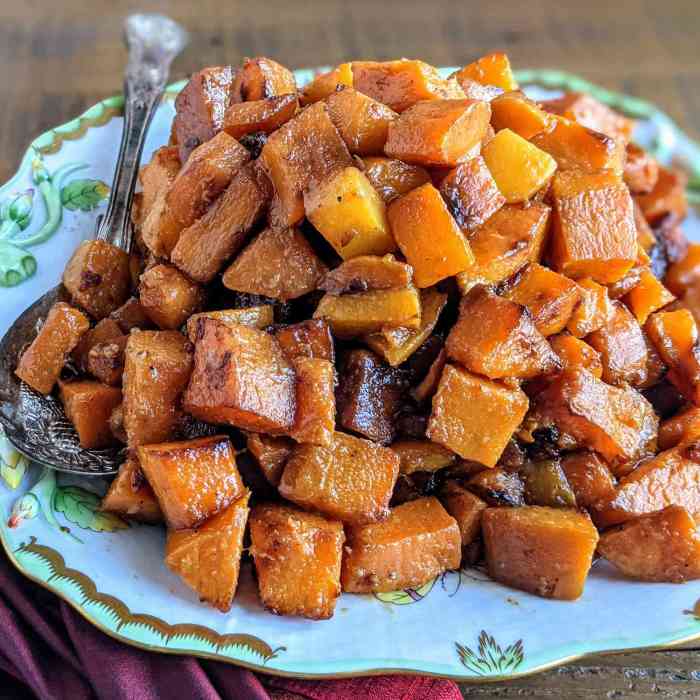
Roasting butternut squash is a simple yet versatile method that brings out its natural sweetness and enhances its flavor. It’s a perfect side dish for any meal, from hearty stews to light salads. The key to successful roasting lies in understanding the different techniques and mastering the art of timing and seasoning.
Simple roasted butternut squash is a versatile side dish that complements a variety of main courses. For a hearty and satisfying meal, try pairing it with baked pork chops i. The sweetness of the squash balances the savory flavor of the pork, creating a delicious and comforting combination.
To enhance the butternut squash’s flavor, try adding a sprinkle of cinnamon or nutmeg before roasting.
Oven Roasting, Simple roasted butternut squash
Oven roasting is the most common and straightforward method for roasting butternut squash. It allows for even cooking and a crispy exterior. The optimal roasting temperature for butternut squash is between 400°F (200°C) and 425°F (220°C). At this temperature, the squash cooks quickly without drying out.
The roasting time depends on the size and thickness of the squash. A medium-sized butternut squash typically takes 45-60 minutes to roast. However, it’s crucial to check for doneness by inserting a fork into the flesh. If it slides in easily, the squash is cooked through.
Seasoning and Flavoring
Seasoning is crucial for enhancing the natural sweetness and depth of flavor of butternut squash. Here are some popular seasoning options:
- Salt and pepper:These are the basic seasonings that enhance the squash’s natural flavors.
- Herbs:Rosemary, thyme, sage, and oregano add a savory and earthy dimension.
- Spices:Cinnamon, nutmeg, and ginger bring warmth and complexity.
- Maple syrup or honey:These sweeteners amplify the squash’s natural sweetness.
Tips for Optimal Roasting
Here are some tips for ensuring a perfectly roasted butternut squash:
- Cut the squash into uniform pieces:This ensures even cooking and prevents some pieces from overcooking while others remain undercooked.
- Toss the squash with oil and seasonings:This helps create a crispy exterior and allows the flavors to penetrate the flesh.
- Roast the squash on a baking sheet lined with parchment paper:This prevents sticking and makes cleanup easier.
- Flip the squash halfway through roasting:This ensures even cooking on all sides.
Air Fryer Roasting
Air frying is a quicker and more efficient method for roasting butternut squash. It utilizes hot air circulation to cook the squash evenly and quickly.The optimal air fryer temperature for butternut squash is between 375°F (190°C) and 400°F (200°C). The roasting time varies depending on the air fryer model and the size of the squash.
However, it generally takes 15-20 minutes for a medium-sized squash.
Tips for Air Fryer Roasting
Here are some tips for air frying butternut squash:
- Cut the squash into smaller pieces:This allows for faster and more even cooking.
- Toss the squash with oil and seasonings:This helps create a crispy exterior and enhances the flavor.
- Avoid overcrowding the air fryer basket:This ensures proper air circulation and prevents uneven cooking.
- Shake the basket halfway through cooking:This helps ensure even browning and prevents sticking.
Flavor Variations
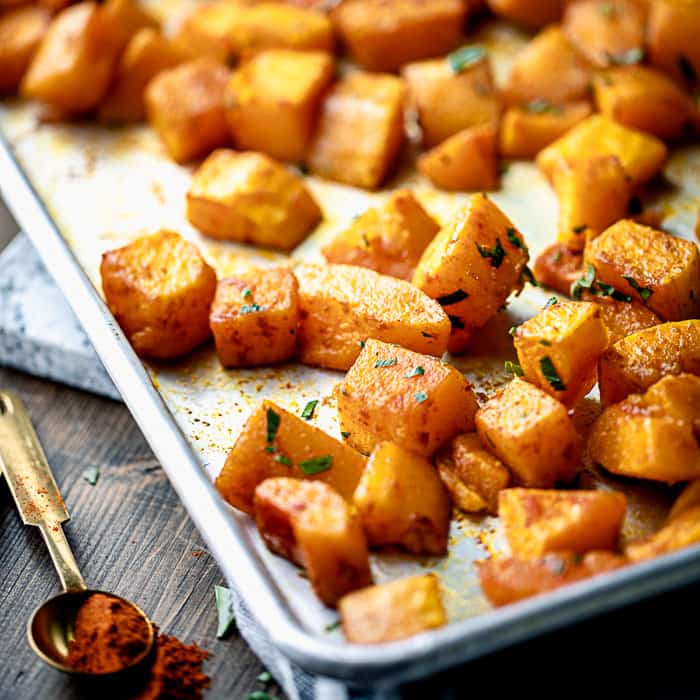
Roasted butternut squash is a versatile side dish that can be easily adapted to complement a wide range of flavors. By incorporating herbs, spices, and other ingredients, you can create an array of unique flavor profiles that will enhance your culinary creations.
Flavor Combinations
The flavor of roasted butternut squash can be enhanced with a variety of herbs, spices, and other ingredients. Here are some popular flavor combinations:
- Sweet and Savory:A combination of maple syrup, brown sugar, cinnamon, and nutmeg adds a sweet and savory touch to the squash. This combination pairs well with roasted chicken, pork, or turkey.
- Herby and Aromatic:Rosemary, thyme, and sage complement the natural sweetness of butternut squash, adding a savory and earthy dimension. This combination works well with roasted lamb or fish.
- Spicy and Warm:Adding chili powder, cumin, and paprika to roasted butternut squash creates a spicy and warming flavor profile. This combination is perfect for pairing with Mexican or Indian dishes.
- Citrusy and Bright:The addition of orange zest and juice brings a bright and citrusy flavor to the butternut squash. This combination pairs well with roasted salmon or chicken.
- Nutty and Earthy:Toasted pecans or walnuts, along with a touch of maple syrup and a pinch of salt, enhance the natural sweetness of the butternut squash and add a nutty and earthy dimension. This combination works well with salads or grain bowls.
Recipes
Here are some recipes that showcase different flavor variations for roasted butternut squash:
Maple-Cinnamon Roasted Butternut Squash
- 1 butternut squash, peeled, seeded, and cubed
- 2 tablespoons olive oil
- 2 tablespoons maple syrup
- 1 teaspoon ground cinnamon
- 1/2 teaspoon ground nutmeg
- 1/4 teaspoon salt
- 1/4 teaspoon black pepper
Preheat oven to 400°F (200°C). Toss the cubed butternut squash with olive oil, maple syrup, cinnamon, nutmeg, salt, and pepper. Spread the squash in a single layer on a baking sheet. Roast for 20-25 minutes, or until tender and slightly caramelized.
Rosemary-Sage Roasted Butternut Squash
- 1 butternut squash, peeled, seeded, and cubed
- 2 tablespoons olive oil
- 1 tablespoon chopped fresh rosemary
- 1 tablespoon chopped fresh sage
- 1/2 teaspoon salt
- 1/4 teaspoon black pepper
Preheat oven to 400°F (200°C). Toss the cubed butternut squash with olive oil, rosemary, sage, salt, and pepper. Spread the squash in a single layer on a baking sheet. Roast for 20-25 minutes, or until tender and slightly caramelized.
Simple roasted butternut squash is a staple in my kitchen, it’s so versatile! I love serving it alongside hearty dishes like a spaetzle sauerkraut and sausage casserole , the sweet and savory flavors complement each other beautifully. And, of course, you can’t go wrong with a drizzle of maple syrup on top of that roasted squash for a touch of sweetness!
Spicy Roasted Butternut Squash
- 1 butternut squash, peeled, seeded, and cubed
- 2 tablespoons olive oil
- 1 teaspoon chili powder
- 1/2 teaspoon cumin
- 1/4 teaspoon paprika
- 1/4 teaspoon salt
- 1/4 teaspoon black pepper
Preheat oven to 400°F (200°C). Toss the cubed butternut squash with olive oil, chili powder, cumin, paprika, salt, and pepper. Spread the squash in a single layer on a baking sheet. Roast for 20-25 minutes, or until tender and slightly caramelized.
Culinary Applications
Roasted butternut squash can be used in a variety of culinary applications, including:
- Salads:Roasted butternut squash adds a sweet and savory element to salads, providing a contrasting texture and flavor.
- Soups and Stews:Roasted butternut squash can be puréed and added to soups and stews, adding depth of flavor and a creamy texture.
- Pasta Dishes:Roasted butternut squash can be incorporated into pasta dishes, adding a unique and flavorful element to the meal.
- Quiches and Tartlets:Roasted butternut squash can be used as a filling for quiches and tartlets, providing a savory and satisfying base.
- Breakfast Bowls:Roasted butternut squash can be added to breakfast bowls, providing a nutritious and flavorful addition to the meal.
Serving Suggestions: Simple Roasted Butternut Squash
Roasted butternut squash, with its naturally sweet and subtly nutty flavor, makes an excellent addition to a variety of dishes. It can be served as a simple side dish, incorporated into salads, soups, and even used as a base for savory tarts and pizzas.
Pairing Roasted Butternut Squash with Main Courses
Roasted butternut squash pairs well with a wide range of main courses, complementing both savory and sweet flavors. Here are some creative pairings:
- Roasted Chicken or Turkey:The sweetness of the squash balances the savory flavors of roasted poultry, creating a well-rounded meal.
- Pork Tenderloin:The nutty flavor of the squash complements the richness of pork, while the sweetness cuts through any potential dryness.
- Salmon or Cod:The delicate sweetness of the squash enhances the flavor of fish, making it an excellent choice for a lighter meal.
- Vegetarian Dishes:Roasted butternut squash is a delicious and satisfying side dish for vegetarian meals, such as lentil stew or vegetable curry.
Incorporating Roasted Butternut Squash into Salads
Roasted butternut squash adds a unique sweetness and texture to salads, providing a delightful contrast to the crisp greens and other ingredients.
- Autumn Salad:Combine roasted butternut squash with kale, pomegranate seeds, toasted pecans, and a tangy vinaigrette for a vibrant and seasonal salad.
- Winter Salad:Toss roasted butternut squash with spinach, crumbled feta cheese, dried cranberries, and a balsamic vinaigrette for a hearty winter salad.
Using Roasted Butternut Squash in Soups
The roasted flavor of butternut squash adds depth and complexity to soups, creating a warm and comforting meal.
- Butternut Squash Soup:Blend roasted butternut squash with vegetable broth, coconut milk, and spices for a creamy and flavorful soup.
- Curried Butternut Squash Soup:Add curry powder, ginger, and garlic to the butternut squash soup for a spicy and aromatic twist.
Presentation Techniques
To enhance the visual appeal of roasted butternut squash, consider these presentation techniques:
- Sliced and Fan-Shaped:Slice the squash lengthwise and arrange the slices in a fan shape on a platter for an elegant presentation.
- Cubed and Tossed with Herbs:Cube the roasted squash and toss it with fresh herbs, such as rosemary or thyme, for a fragrant and visually appealing side dish.
- Garnished with Toasted Nuts:Sprinkle toasted pecans, walnuts, or almonds over the roasted squash for added texture and visual interest.
Storage and Leftovers
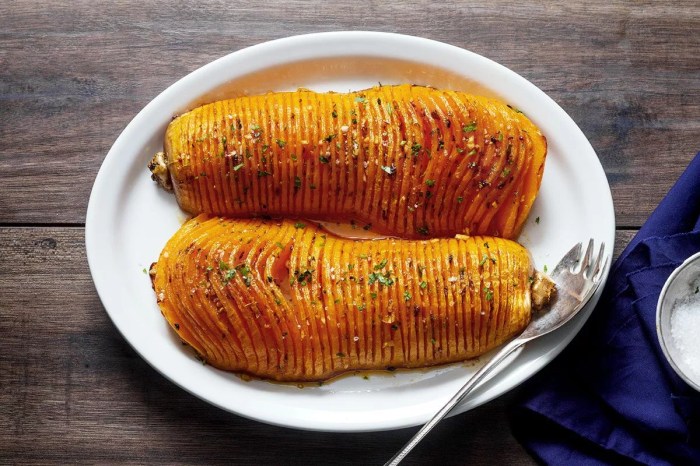
Roasted butternut squash, with its rich flavor and versatility, is a great dish to make ahead. Whether you’ve made a little too much or want to enjoy the goodness later, storing and reheating leftovers is simple and ensures you can savor the flavors.
Storing Roasted Butternut Squash
Storing roasted butternut squash is straightforward. Allow it to cool completely before transferring it to an airtight container. Store the container in the refrigerator for up to 3-4 days. This will preserve the squash’s texture and flavor, allowing you to enjoy it later.
Reheating Roasted Butternut Squash
Reheating roasted butternut squash is best done gently to avoid overcooking and drying it out. Here are a few methods you can use:
Oven Reheating
Preheat your oven to 350°F (175°C). Place the roasted butternut squash on a baking sheet and heat for 10-15 minutes, or until warmed through.
Microwave Reheating
Transfer the roasted butternut squash to a microwave-safe dish. Heat on medium power for 1-2 minutes, or until warmed through.
Stovetop Reheating
Place the roasted butternut squash in a saucepan with a small amount of water or broth. Heat over medium heat, stirring occasionally, until warmed through.
Repurposing Leftover Roasted Butternut Squash
Leftover roasted butternut squash is a blank canvas for creativity. It can be incorporated into various dishes, adding a touch of sweetness and depth of flavor. Here are a few ideas:
Salads
Add chunks of roasted butternut squash to your favorite salads for a boost of sweetness and texture. Combine it with greens, nuts, and a tangy vinaigrette for a delicious and satisfying meal.
Soups
Puree roasted butternut squash and blend it into your favorite soup recipes. It adds a creamy richness and a touch of sweetness.
Pasta Dishes
Toss roasted butternut squash with pasta, herbs, and cheese for a simple and flavorful meal. You can also add it to creamy pasta sauces for a unique twist.
Breakfast Dishes
Add roasted butternut squash to your morning oatmeal or yogurt for a nutritious and flavorful start to your day. Its sweetness pairs well with the creamy texture of oatmeal or yogurt.
Other Ideas
You can also use leftover roasted butternut squash to create dips, spreads, or even fillings for pastries and tarts. Get creative and explore the endless possibilities!

